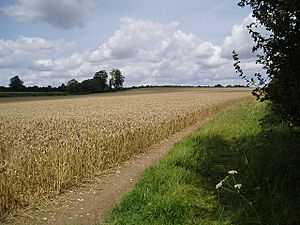Hampshire Downs facts for kids

The Hampshire Downs are a big area of rolling hills in central, southern England. Most of these hills are in the county of Hampshire. They are part of a long stretch of chalk hills. This chalk belt goes from the South Downs in the southeast, up to the Berkshire Downs and North Wessex Downs, and west to the Dorset Downs.
These downs are recognized as a special natural area. It's called a National Character Area (NCA 130) by Natural England. This is the UK government's group that advises on nature.
Contents
Where are the Hampshire Downs?
The Hampshire Downs are surrounded by other interesting places. To the north, you'll find the Thames Basin Heaths. To the east is the Weald, which is a lowland area. To the south, there are the South Hampshire Lowlands and the South Downs. To the west, you'll see Salisbury Plain and the North Wessex Downs.
Borders of the Downs
The northern edge of the Hampshire Downs starts near Walbury Hill in Berkshire. It then goes towards Basingstoke and Farnham. This northern border is a high ridge. It forms a dramatic steep slope, rising over 290 metres high. From here, you can look out over the Thames Basin.
To the east, the border goes from Farnham to Alton. Then it turns south towards Petersfield. This part also forms a steep slope. It's on the western side of the Weald. This area includes a place known as the East Hampshire Hangers.
The southern border runs west to Winchester. It then goes south to Twyford and Otterbourne. From there, it heads west-northwest to Michelmersh. The western border goes from Michelmersh through the Wallops. It continues to Ludgershall and Marten. Finally, it loops back to Walbury Hill.
Rivers and Towns
The two main rivers flowing through the Hampshire Downs are the River Test and the River Itchen.
The biggest towns in the Hampshire Downs include Andover, Alton, Basingstoke, and Winchester.
Protecting the Landscape
A part of the Hampshire Downs is protected for its natural beauty. About 20% of the area is within the North Wessex Downs AONB. An AONB is a special place recognized for its beautiful landscapes.
Also, around 6% of the Hampshire Downs is part of the South Downs National Park. National Parks are large areas protected for their natural beauty, wildlife, and cultural heritage.
Highest Hills of the Hampshire Downs
Pilot Hill is the highest point in the Hampshire Downs. It is also the highest point in the entire county of Hampshire. This makes it Hampshire's "county top."
Here are some of the other tall hills in the Hampshire Downs:
- Pilot Hill (286 metres)
- Butser Hill (271 metres)
- Sidown Hill (266 metres)
- Beacon Hill (261 metres)
- Wheatham Hill (249 metres)
- Watership Down (237 metres)
- Ladle Hill (232 metres)
- Holybourne Hill (225 metres)
- Red Hill (221 metres)
- Goleigh Hill (220 metres)
- King's Hill (218 metres)
- Noar Hill (214 metres)
- Selborne Hill (211 metres)
- Farleigh Hill (208 metres)
- Farley Mount (178 metres)
- St. Catherine's Hill (97 metres)

